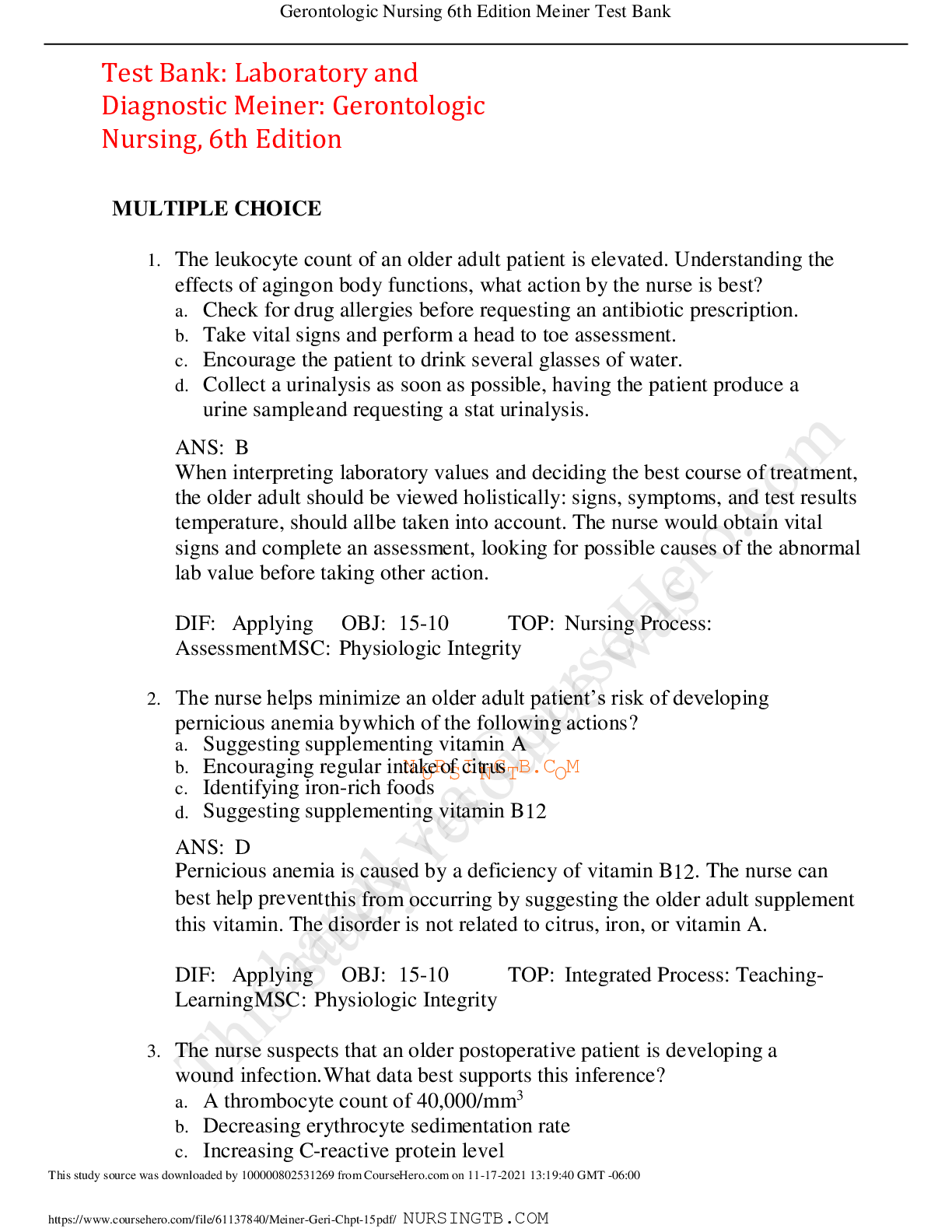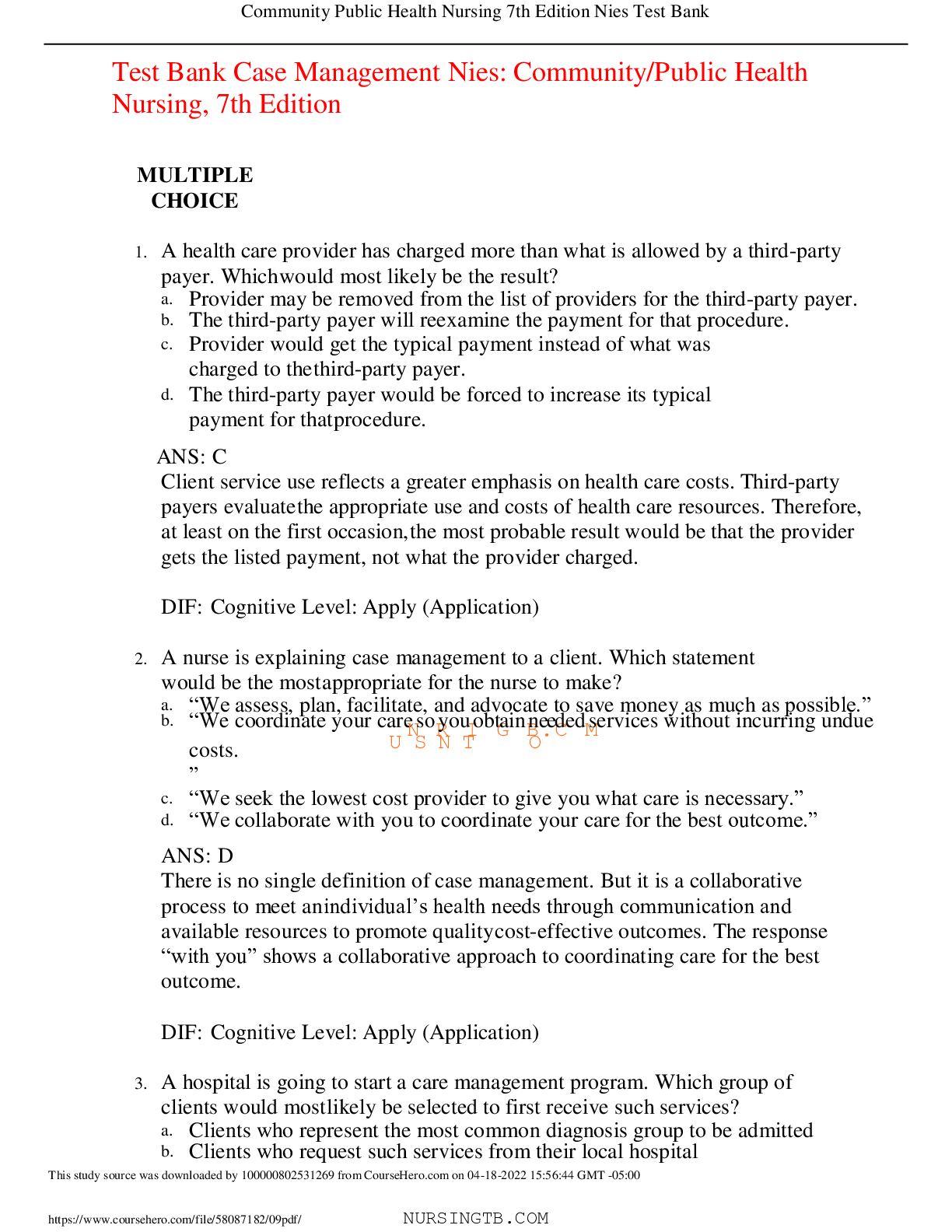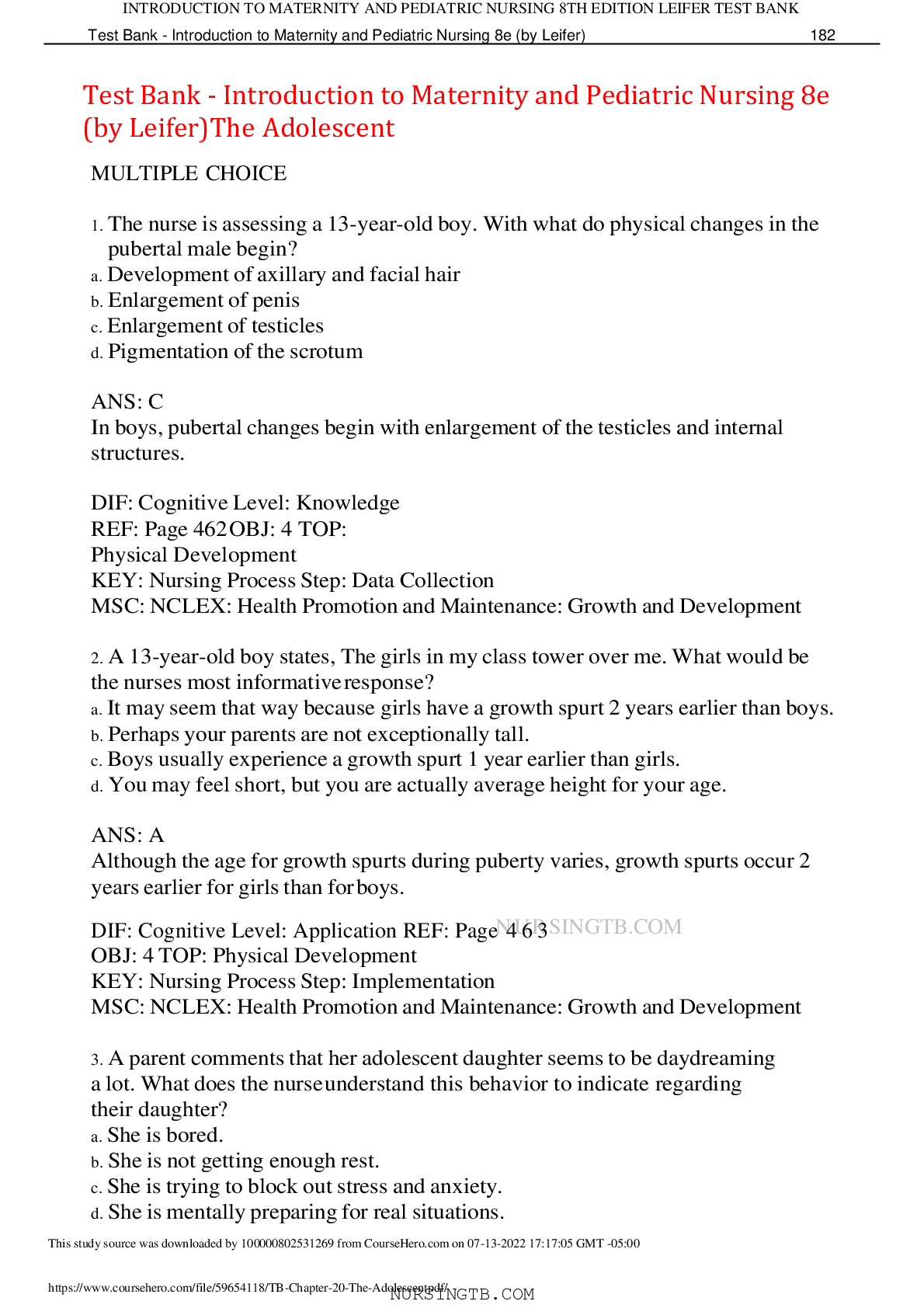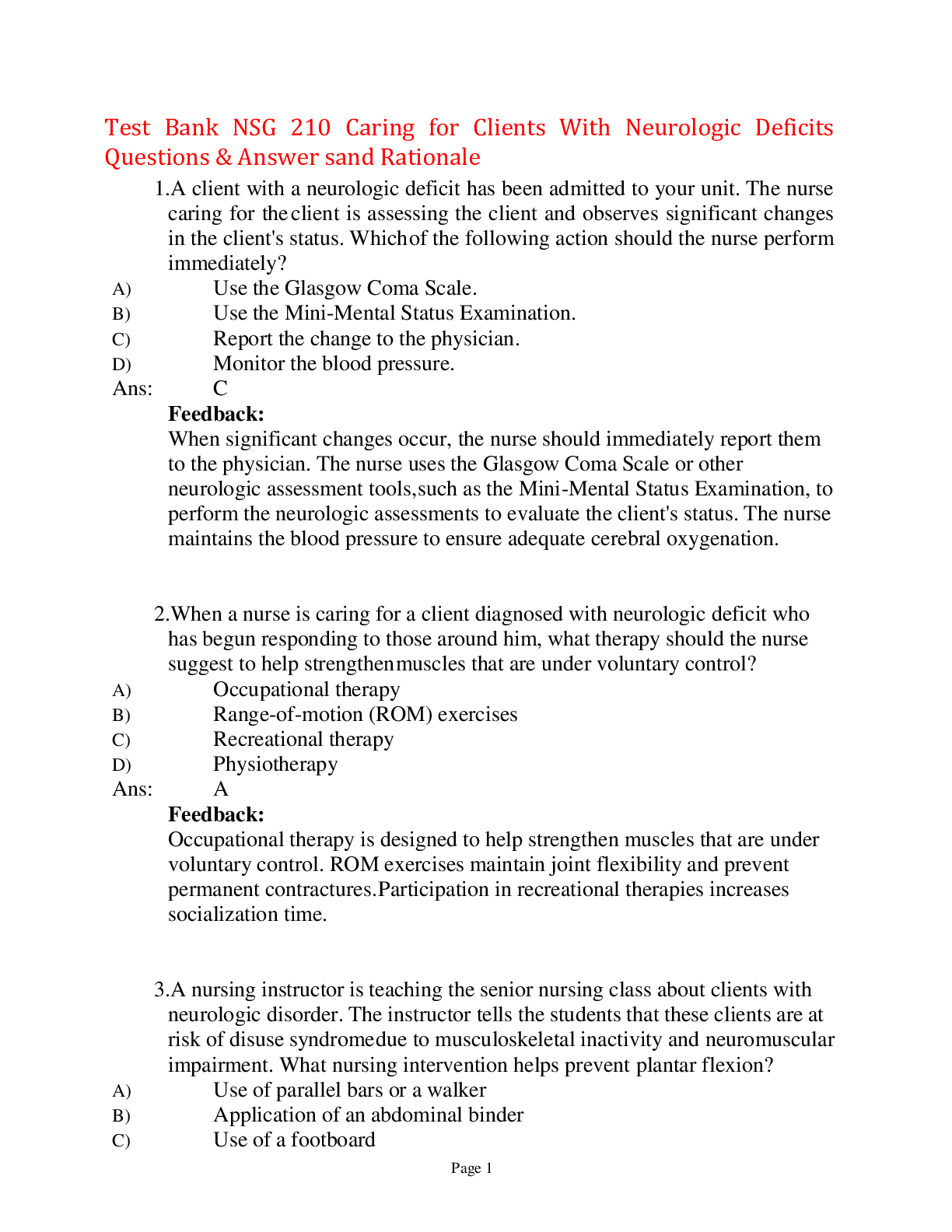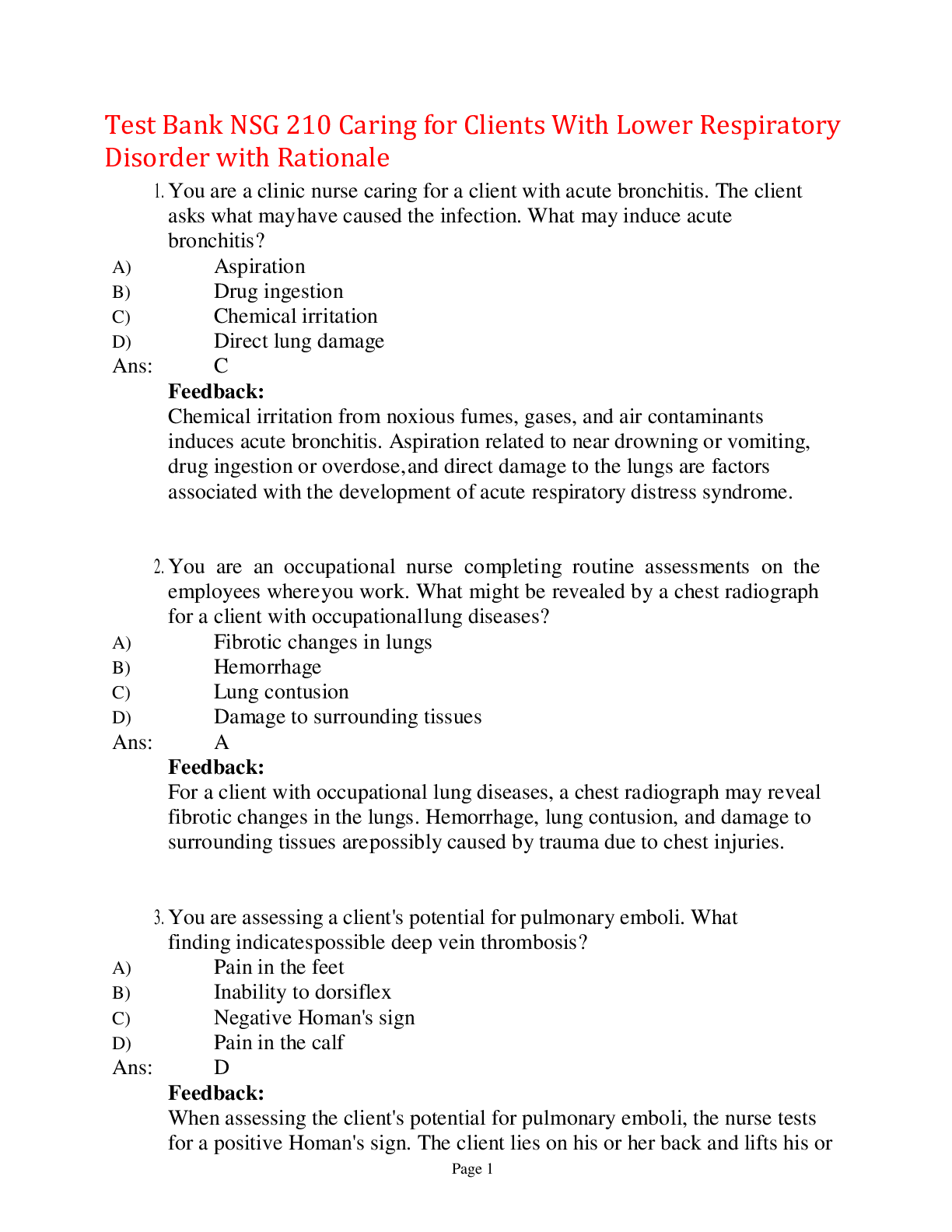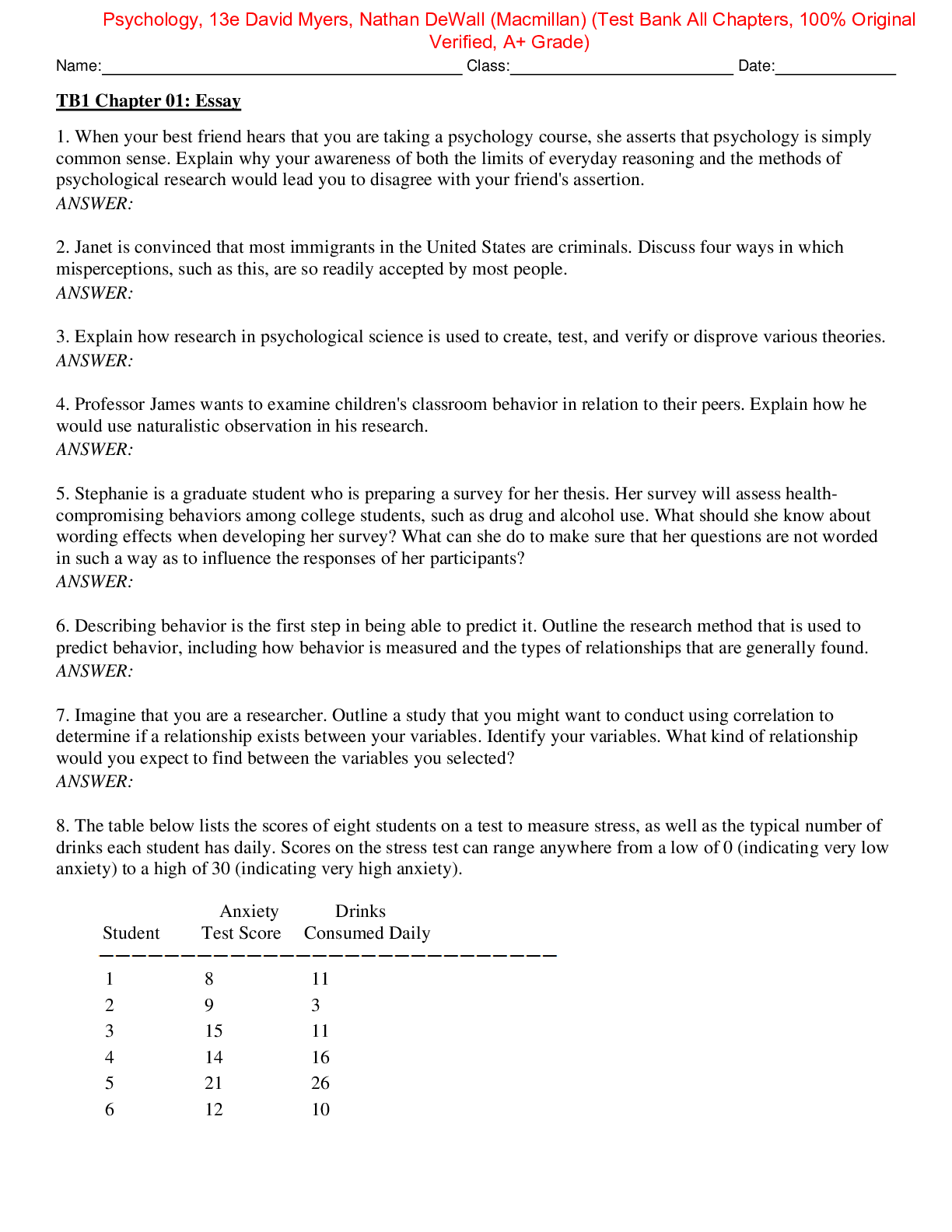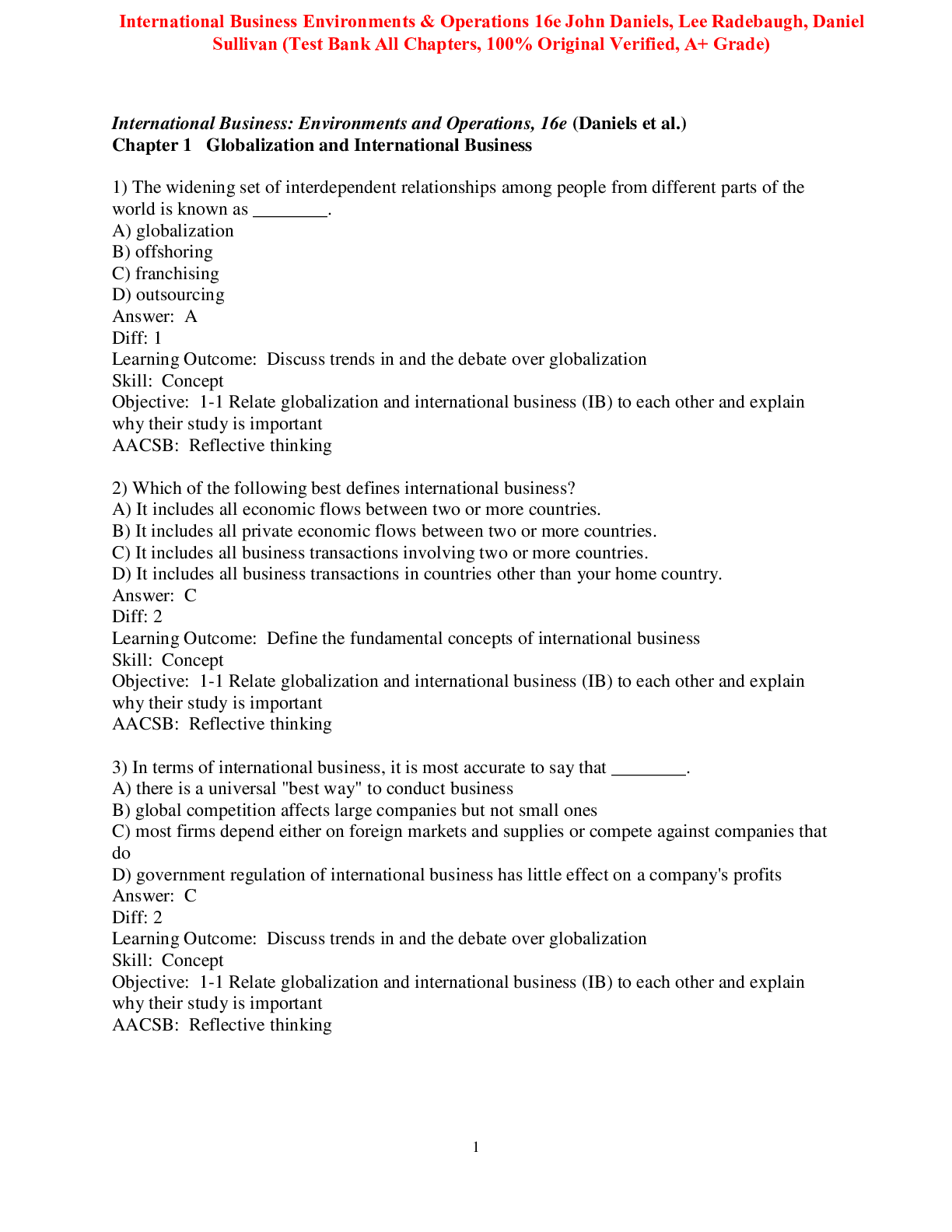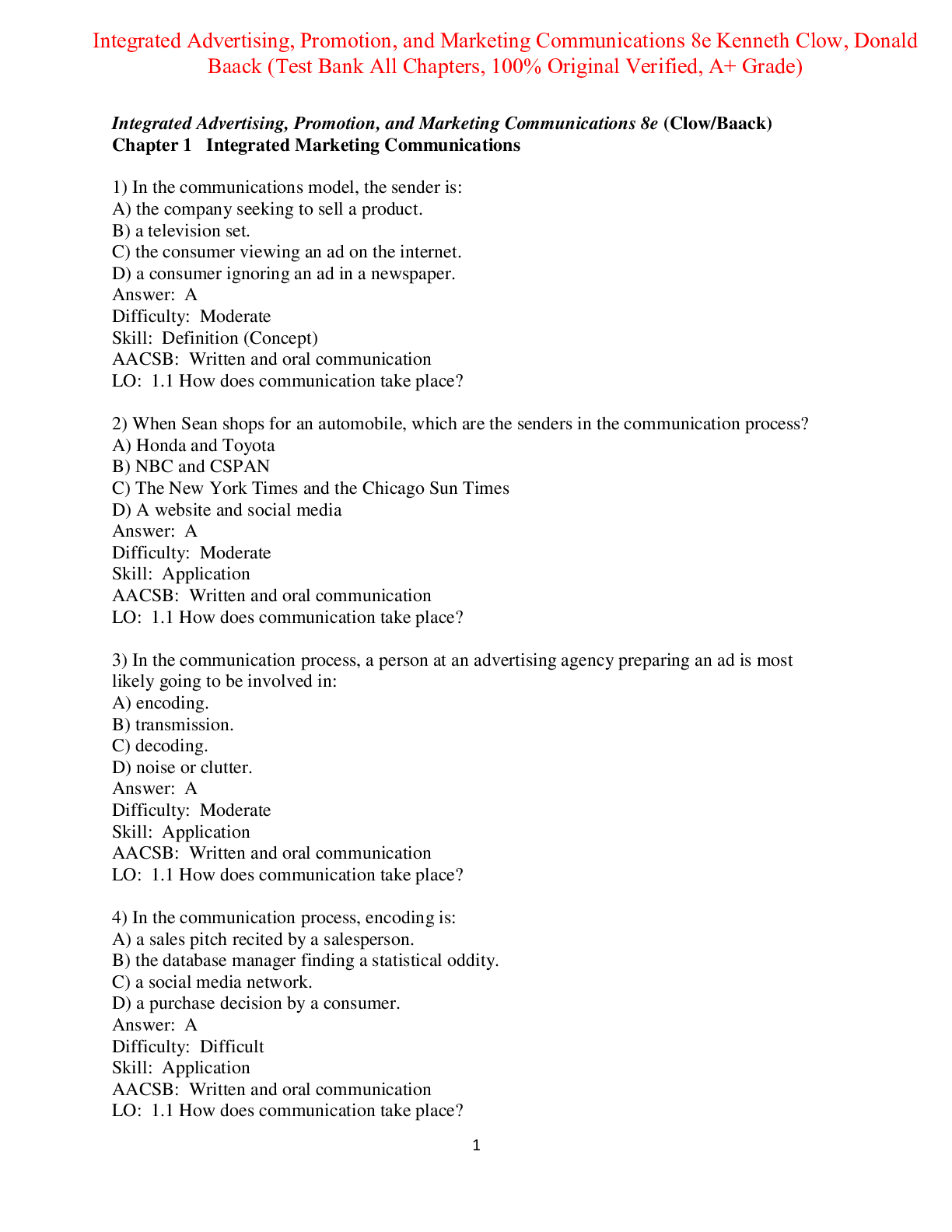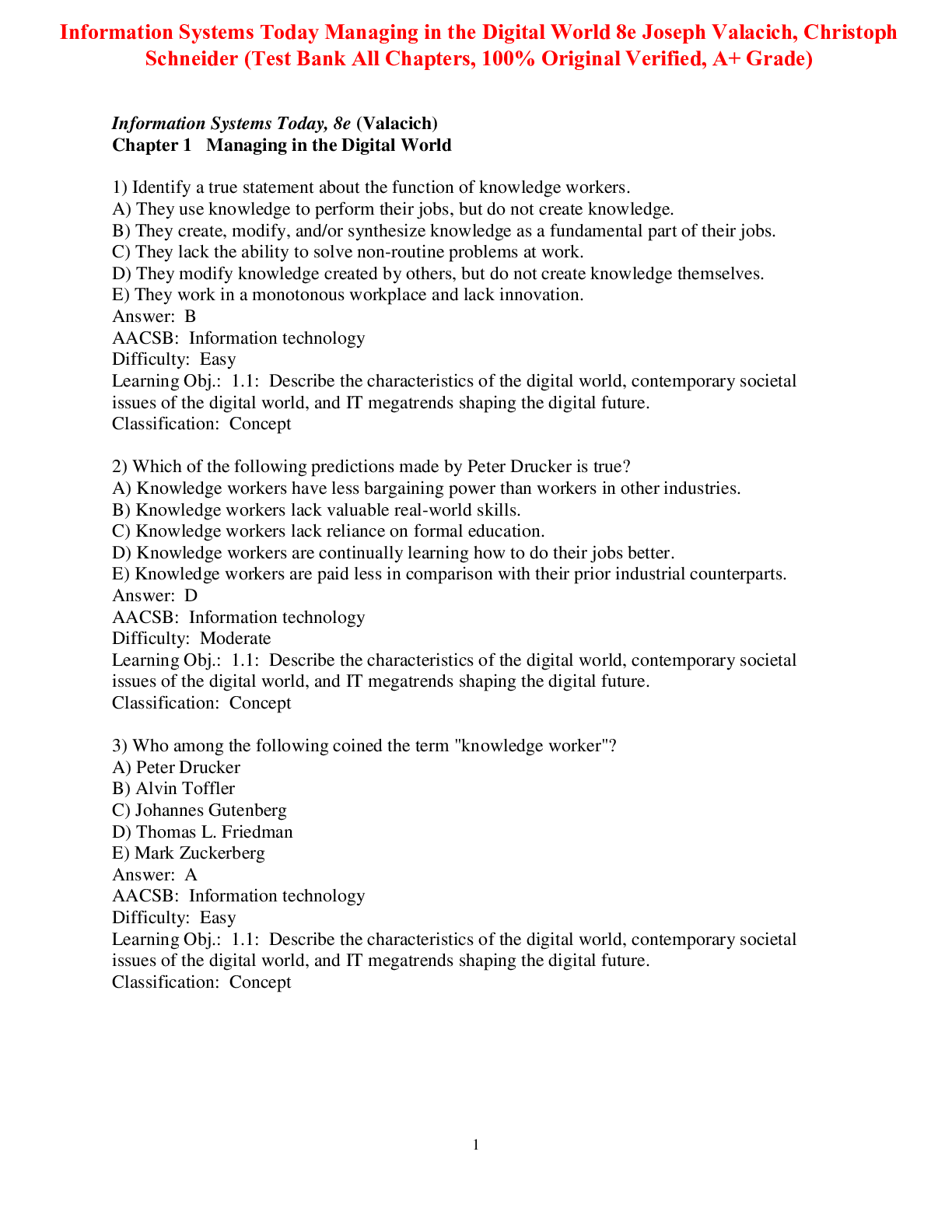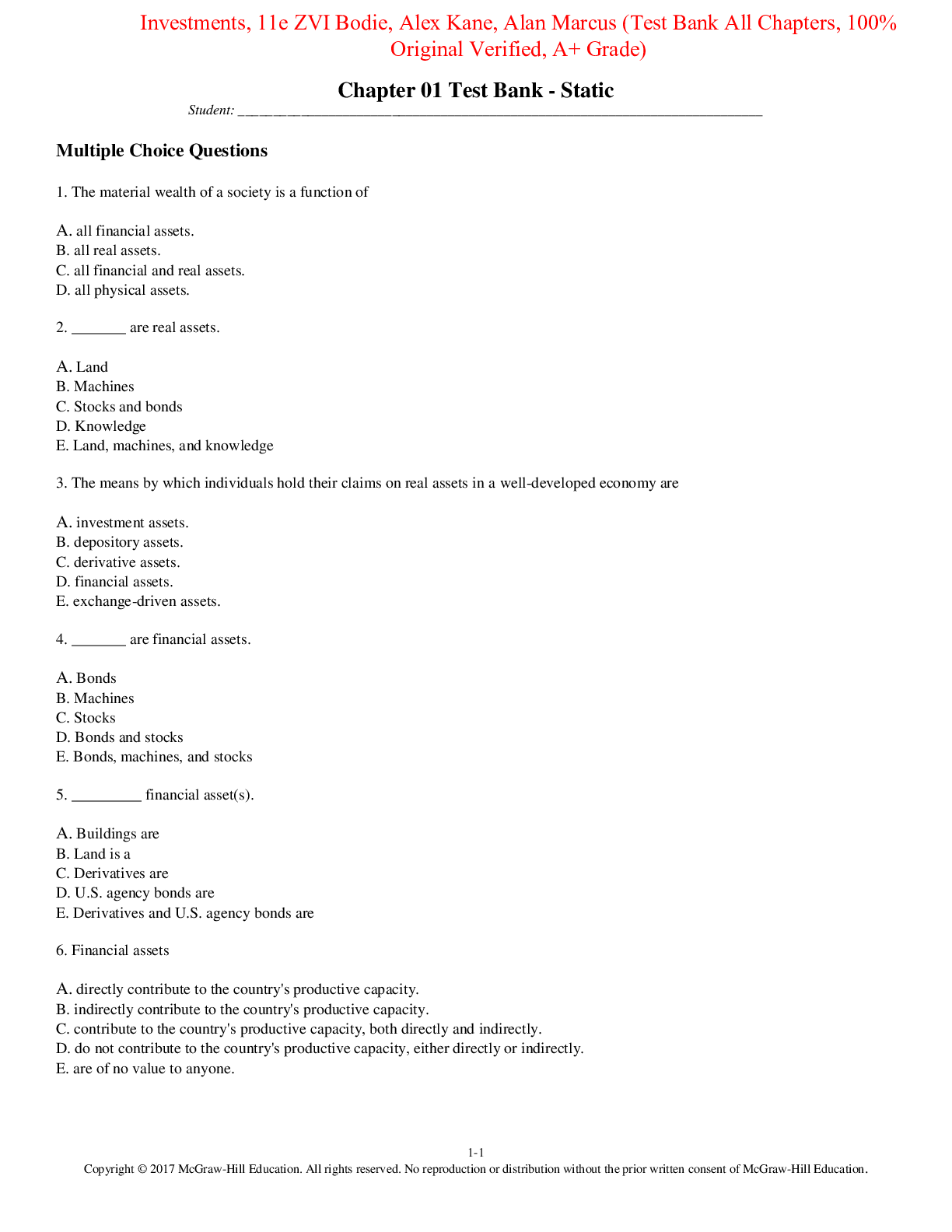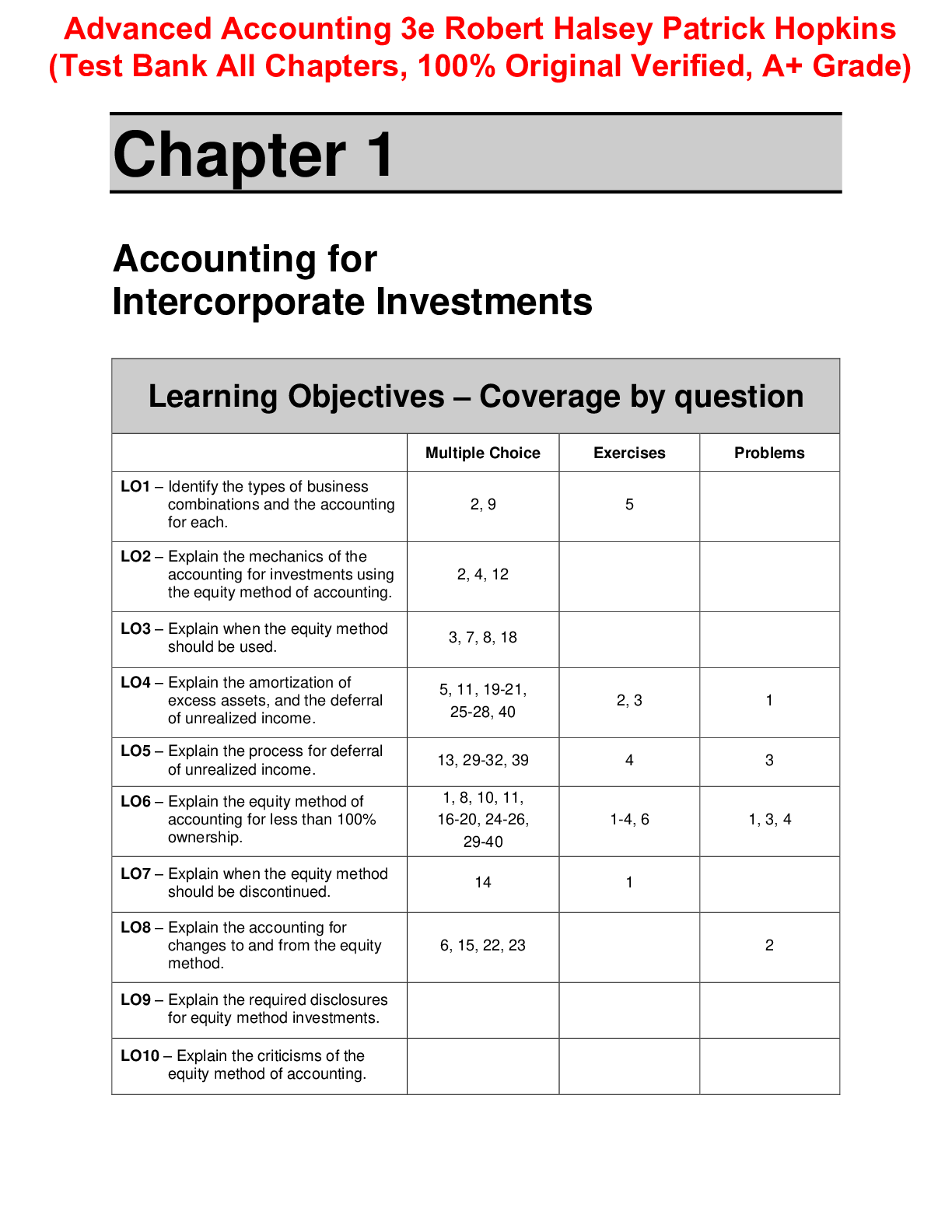*NURSING > TEST BANK > Test Bank NSG 210 Caring for Clients With Disorders of Coronary Questions &Answers & Rationale,100% (All)
Test Bank NSG 210 Caring for Clients With Disorders of Coronary Questions &Answers & Rationale,100% CORRECT
Document Content and Description Below
Test Bank NSG 210 Caring for Clients With Disorders of Coronary Questions &Answers & Rationale 1. You are caring for a client with coronary artery disease (CAD). What is an appropriate nursing action... when evaluating a client with CAD? A) Assess the client's mental and emotional status. B) Assess the skin of the client. C) Assess the characteristics of chest pain. D) Assess for any kind of drug abuse. Ans: C Feedback: The nurse should assess the characteristics of chest pain for a client with CAD. Assessing the client's mental and emotional status, skin, or for drug abuse will not assist the nurse in evaluating the client for CAD. The assessment should be aimed at evaluating for adequate blood flow to the heart. 2. The nurse is caring for a client with Raynaud's disease. What is an important instruction for a client who is diagnosed with this disease to prevent an attack? A) Report changes in the usual pattern of chest pain. B) Avoid situations that contribute to ischemic episodes. C) Avoid fatty foods and exercise. D) Take over-the-counter decongestants. Ans: B Feedback: Teaching for clients with Raynaud's disease and their family members is important. They need to understand what contributes to an attack. The nurse should instruct the clients to avoid situations that contribute to ischemic episodes. Reporting changes in the usual pattern of chest pain or avoiding fatty foods and exercise does not help the client to avoid an attack; it is more contributory for clients with CAD. In addition, the nurse advises clients to avoid over-the-counter decongestants. 3. You are caring for a client at risk for thrombosis. What is an appropriate nursing action when evaluating this client? A) Examine the client's mental and emotional status. B) Examine the legs for color, capillary refill time, and tissue integrity. C) Examine for pain around the shoulder and neck region. D) Examine the extremities for skin lesions. Ans: B Feedback: The nurse examines the extremities and assesses skin color, temperature, capillary refill time, and tissue integrity and not for skin lesions for clients with thrombosis. Examining the client's mental and emotional status or examining for pain around the shoulder and neck region will not assist the nurse in evaluating a client with thrombosis. 4.A client has had oral anticoagulation ordered. What should you monitor for when your client is taking oral anticoagulation? A) Prothrombin time (PT) or international normalized ratio (INR) B) Hourly IV infusion C) Vascular sites for bleeding D) Urine output Ans: A Feedback: The nurse should monitor PT or INR when oral anticoagulation is prescribed. Vascular sites for bleeding, urine output, and hourly IV infusions are generally monitored in all clients. 5. The nurse is working with a client who has just been diagnosed with an aneurysm. What advice should the nurse provide to this client? A) Minimize bowel movements and coughing. B) Avoid situations that contribute to ischemic episodes. C) Avoid straining during bowel movements and coughing. D) Wear wool socks and mittens during cold weather. Ans: C Feedback: The nurse advises the client with an aneurysm to avoid straining during bowel movements and coughing. Coughing and straining increase the risk of rupture. The client with Raynaud's disease is asked to avoid situations that contribute to ischemic episodes and to wear wool socks and mittens during cold weather. 6. You are presenting a workshop at the senior citizens center about how the changes of aging predispose clients to vascular occlusive disorders. What would you name as the most common cause of peripheral arterial problems in the older adult? A) Arteriosclerosis B) Coronary thrombosis C) Atherosclerosis D) Raynaud's disease Ans: C Feedback: Atherosclerosis is the most common cause of peripheral arterial problems in the older adult. The disease correlates with the aging process. The other choices may occur at any age. 7.A patient presents to the emergency room with characteristics of atherosclerosis. What characteristics would the patient display? A) Fatty deposits in the lumen of arteries B) Cholesterol plugs in the lumen of veins C) Blood clots in the arteries D) Emboli in the veins Ans: A Feedback: Atherosclerosis is a condition in which the lumen of arteries fill with fatty deposits called plaque. Therefore, options B, C, and D are incorrect. 8.A client comes to the emergency department (ED) complaining of precordial chest pain. In describing the pain, the client describes it as pressure with a sudden onset. What disease process would you suspect in this client? A) Coronary artery disease B) Raynaud's disease C) Cardiogenic shock D) Venous occlusive disease Ans: A Feedback: The classic symptom of CAD is chest pain (angina) or discomfort during activity or stress. Such pain or discomfort typically is manifested as sudden pain or pressure that may be centered over the heart (precordial) or under the sternum (substernal). Raynaud's disease in the hands presents with symptoms of hands that are cold, blanched, and wet with perspiration. Cardiogenic shock is a complication of an MI. Venous occlusive disease occurs in the veins, not the arteries. 9. You are caring for a client who is suspected of having coronary artery disease. The client is scheduled to have a nuclear stress test using thallium. When would the thallium be injected to determine narrowing of the coronary arteries? A) During and a few hours after exercise electrocardiography B) Before and during exercise electrocardiography C) Before and a few hours after exercise electrocardiography D) Before, during, and a few hours after exercise electrocardiography Ans: A Feedback: A nuclear stress test using a radionuclide, such as thallium, may be injected intravenously (IV) during and a few hours after exercise electrocardiography, followed by a heart scan. Narrowing of one or more coronary arteries is documented during coronary arteriography. Therefore, options B, C, and D are incorrect. 10. The nurse is caring for a client who is status postoperative from a vein stripping. What would the nurse monitor for? A) Swelling in the inoperative leg B) Blood on the dressing on the inoperative leg C) Warm, pink toes in the inoperative leg D) Swelling in the operative leg Ans: D Feedback: When the client returns from surgery with a gauze dressing covered by elastic roller bandages on the operative leg, the nurse monitors for swelling in the operative leg(s) and its effect on circulation. 11. Understanding atherosclerosis, the nurse identifies which of the following to be both a risk factor for the development of the disorder and an outcome? A) Hyperlipidemia B) Hypertension C) Glucose intolerance D) Obesity Ans: B Feedback: Increases in diastolic and systolic blood pressure are associated with an increased incidence of atherosclerosis, often an inherited factor. Elevation of blood pressure results when the vessels cannot relax and impairs the ability of the artery to dilate. Hyperlipidemia, diabetes, and obesity are all risk factors for atherosclerosis but do not result from the disorder. 12. The client asks the nurse to explain the difference between arteriosclerosis and atherosclerosis. Which is the best explanation provided by the nurse? A) “Arteriosclerosis is a condition that produces structural changes in the arteries, and atherosclerosis is a specific type of arteriosclerosis.” B) “Arteriosclerosis and atherosclerosis are the same disorder. The terms are interchangeable.” C) “Atherosclerosis and arteriosclerosis are disorders in which the lining of the vessels become narrowed due to plaque formation.” D) “Arteriosclerosis is when the vessels become dilated and weakened, whereas atherosclerosis is the deposit of fatty substances in the vessel lining.” Ans: A Feedback: Arteriosclerosis is a complex condition that produces structural changes to the arteries usually associated with loss of elasticity. Atherosclerosis is a specific type and most common cause of arteriosclerosis. Both disorders affect the ability of the vessels to deliver blood and are considered occlusive disorders, but the causes differ. Vessels that become dilated and weakened are referred to as aneurysms, not arteriosclerosis. 13.A study published in the American Journal of Physiology, Endocrinology, and Metabolism (You et al., 2005), reported findings that suggest inflammation increases the risk of heart disease. Which modifiable factor would the nurse target in teaching clients about prevention of inflammation that can lead to atherosclerosis? A) Smoking B) Inactivity C) Obesity D) Blood pressure control Ans: C Feedback: The American Journal of Physiology, Endocrinology, and Metabolism (You et al., 2005) indicated a relationship between body fat and the production of inflammation that is associated with heart disease. This information suggests decreasing obesity and body fat stores may help to reduce the risk. Smoking, inactivity, and uncontrolled blood pressure are risk factors associated with heart disease but not specific to inflammatory protein production. 14.Which of the following nursing assessment findings are suggestive of increased risk for coronary artery disease? Select all that apply. A) Arcus senilis B) Pear-shaped body C) Plump ear lobes D) Xanthelasma E) Sensory loss F) Motor changes Ans: A, D Feedback: Arcus senilis is the opaque ring seen around the cornea that results from deposit of fat granules, and xanthelasma is raised yellow plaque on the eyelids. Both of these findings are suggestive of lipid accumulation that can increase the risk of CAD. An apple-shaped body carries a higher risk. Diagonal creases in the earlobe have been suggestive of CAD. Sensory and motor changes are more associated with CVA than CAD. 15.A client is being evaluated for coronary artery disease (CAD) and is scheduled for an electron beam computed tomography. The nurse understands that the primary advantage of this radiologic test is which of the following? A) Less exposure to radiation B) Clear images C) Less invasive procedure D) Quantifies calcified plaque Ans: D Feedback: The primary advantage of EBCT is to detect and quantify calcified plaque in the coronary arteries even before symptoms arise. EBCT is noninvasive and provides clearer images with less exposure to radiation than a CT scan but not the primary reason for use. 16.In the treatment of coronary artery disease (CAD), medications are often ordered to control blood pressure in the client. Which of the following is a primary purpose of using beta-adrenergic blockers in the nursing management of CAD? A) To dilate coronary arteries B) To decrease workload of the heart C) To decrease homocysteine levels D) To prevent angiotensin II conversion Ans: B Feedback: Beta-adrenergic blockers are used in the treatment of CAD to decrease the myocardial oxygen by reducing heart rate and workload of the heart. Nitrates are used for vasodilation. Anti-lipid drugs (such as statins and B vitamins) are used to decrease homocysteine levels. ACE inhibitors inhibit the conversion of angiotensin. 17.A client is ordered a nitroglycerine transdermal patch for treatment of CAD and asks the nurse why the patch is removed at bedtime. Which is the best response by the nurse? A) “Nitroglycerine causes headaches, but removing the patch decreases the incidence.” B) “You do not need the effects of nitroglycerine while you sleep.” C) “Removing the patch at night prevents drug tolerance while keeping the benefits.” D) “Contact dermatitis and skin irritations are common when the patch remains on all day.” Ans: C Feedback: Tolerance to antiangina effects of nitrates can occur when taking these drugs for long periods of time. Therefore, to prevent tolerance and maintain benefits, it is a common regime to remove transdermal patches at night. Common adverse effects of nitroglycerine are headaches and contact dermatitis but not the reason for removing the patch at night. It is true that while you rest, there is less demand on the heart but not the primary reason for removing the patch. 18.Clients taking vasodilator drugs can be a greater risk for postprandial hypotension. Which of the following is the best nursing explanation for this phenomenon? A) Gravity pulls blood to the lower extremities while sitting. B) Blood is being diverted to the gastrointestinal tract. C) Decreased peripheral blood flow results. D) Bronchospasms are increased when food enters the stomach. Ans: B Feedback: During digestion, blood is diverted to the GI tract which decreases cerebral blood flow and increases potential of orthostatic hypotension. Although gravity does pull blood to the lower extremities while sitting, this is not the primary concern with postprandial hypotension. Decreased peripheral blood flow does not result in postprandial hypotension. Bronchospasms are associated more with asthma not diversion of blood flow. 19.A client with a strong family history of coronary artery disease asks the nurse how to reduce the risk of developing the disorder. Which is the best response by the nurse? A) “Moderation is the key to everything.” B) “Ask your physician to prescribe the new reverse lipid drug.” C) “Increase the soy in your diet.” D) “Exercise, keep your cholesterol in check, and manage your stress.” Ans: D Feedback: Although moderation is the key, this does not provide specific options for this client such as regular exercise and managing stress and cholesterol levels. The reverse lipid drug sounds good but is not available or approved by the FDA. Soy products have limited benefits for cholesterol control. 20.A client, who has undergone a percutaneous transluminal coronary angioplasty (PTCA), has received discharge instructions. Which statement by the client would indicate the need for further teaching by the nurse? A) “I should avoid taking a tub bath until my catheter site heals.” B) “I should expect a low-grade fever and swelling at the site for the next week.” C) “I should avoid prolonged sitting.” D) “I should expect bruising at the catheter site for up to 3 weeks.” Ans: B Feedback: Fever and swelling at the site are signs of infection and should be reported to the physician. Showers should be taken until the insertion site is healed. Prolonged sitting can result in thrombosis formation. Bruising at the insertion site is common and may take from 1 to 3 weeks to resolve. 21. Which nursing actions would be of greatest importance in the management of a client preparing for angioplasty? A) Inform client of diagnostic tests. B) Remove hair from skin insertion sites. C) Assess distal pulses. D) Withhold anticoagulant therapy. Ans: D Feedback: The nurse knows to withhold the anticoagulant therapy to decrease chance of hemorrhage during the procedure. The nurse does inform the client of diagnostic test, will assess pulses, and prep the skin prior to the angioplasty, but this is not the most important action to be taken. 22. Dysrhythmias can be fatal to a client during the acute phase following a myocardial infarction. The nurse understands that the primary cause of this event is due to which of the following? A) Effects on depolarization and repolarization of the myocardial cells B) Arterial spasms are common after a myocardial infarction. C) After a myocardial infarction, leukocytosis occurs. D) Scar tissue has replaced healthy cardiac tissue. Ans: A Feedback: Dysrhythmias during the acute phase occur because the affected areas are electrically unstable due to the shifting of electrolytes and accumulation of lactic acid, which affect the depolarization and repolarization of the myocardial cells. Arterial spasms can be a cause of MI, not a result. Leukocytosis does occur after a MI but not the cause of dysrhythmias. Scar tissue formation takes weeks to form and does not occur in the acute phase. 23. The nurse knows that women and the elderly are at greater risk for a fatal myocardial event. Which factor is the primary contributor of this cause? A) Chest pain is typical B) Vague symptoms C) Decreased sensation to pain D) Gender bias Ans: B Feedback: Often, women and elderly do not have the typical chest pain associated with a myocardial infarction. Some report vague symptoms (fatigue, abdominal pain), which can lead to misdiagnosis. Some older adults may experience little or no chest pain. Gender is not a contributing factor for fatal occurrence but rather a result of symptoms association. 24. Severe chest pain is reported by a client during an acute myocardial infarction. Which of the following is the most appropriate drug for the nurse to administer? A) Isosorbide mononitrate (Isordil) B) Meperidine hydrochloride (Demerol) C) Morphine sulfate (Morphine) D) Nitroglycerin transdermal patch Ans: C Feedback: Morphine not only decreases pain perception and anxiety but also helps to decrease heart rate, blood pressure, and demand for oxygen. Nitrates are administered for vasodilation and pain control in clients with angina–type pain, but oral forms (such as Isordil) have a large first-pass effect, and transdermal patch is used for long-term management. Demerol is a synthetic opioid usually reserved for treatment of postoperative or migraine pain. 25. After 2-hour onset of acute chest pain, the client is brought to the emergency department for evaluation. Elevation of which diagnostic findings would the nurse identify as suggestive of an acute myocardial infarction at this time? A) Troponin I B) Myoglobin C) WBC (white blood cell) count D) C-reactive protein Ans: B Feedback: Myoglobin is a biomarker that rises in 2 to 3 hours after heart damage. Troponin is the gold standard for determining heart damage, but troponin I levels due not rise until 4 to 6 hours after MI. WBCs and C-reactive protein levels will rise but not until about day 3. 26.A client is scheduled for a percutaneous transluminal coronary angioplasty (PTCA) immediately following confirmed diagnosis of acute myocardial infarction. The client is overtly anxious and crying. Which response by the nurse is most appropriate? A) “Everything will be fine. Your family is here for you.” B) “Don't cry; you have the best team of doctors.” C) “Would you like something to calm your nerves?” D) “Tell me what concerns you most.” Ans: D Feedback: Allowing the client to share feelings tends to relieve or reduce emotional distress. Telling a client that everything is fine negates the feelings they are expressing. Telling a client not to cry can be viewed as insensitive to the feelings being expressed. Providing a prescribed sedative may be helpful but does not address the fears and concerns of the client. 27.Following a percutaneous transluminal coronary angioplasty (PTCA), which of the following nursing assessments would be considered as primary for this client? A) Evaluate for signs of infection. B) Monitor gag reflex. C) Assess peripheral pulses in affected extremity. D) Monitor for signs of fluid volume deficit. Ans: C Feedback: The PTCA is inserted and threaded through a peripheral artery. If a complication occurs at the site of insertion, impaired circulation to the affected limb can occur. Fluid volume deficit is not a primary concern. PTCA is an invasive, nonsurgical procedure in which general anesthesia is not required, making monitoring for impaired gag reflex a nonpriority. Signs of infection should be monitored post-PTCA but not in the immediate postprocedure time frame. 28.A client, who is resting in bed, presents with symptoms of poikilothermy, bilateral lower extremity edema, and pallor. Which is the best nursing measure to initiate? A) Elevate the legs. B) Apply cool compresses. C) Smoking cessation class. D) Lower the legs. Ans: D Feedback: These are symptoms of peripheral artery disease. By lowering the legs, blood flow will be increased to the lower extremities. Elevation of the legs would be helpful in the management of impaired venous blood return. Smoking cessation is paramount but not the initial action to be taken, and cool compresses stimulate vasoconstriction and further impede blood flow. 29.Which nursing diagnosis is most significant in planning the care for a client with Raynaud's disease? A) Acute Pain B) Disturbed Sensory Perception C) Self-Care Deficit D) Activity Intolerance Ans: A Feedback: The hallmark symptom of Raynaud's Disease is pain related to the arterial insufficiency. Disturbed Sensory Perception associated with paresthesia can occur but is less significant than pain. Self-Care Deficit and Activity Intolerance can occur but less significant than Acute Pain. 30.A client with Raynaud's disease complains of cold and numbness in the fingers. Which of the following would the nurse identify as an early sign of vasoconstriction? A) Cyanosis B) Gangrene C) Pallor D) Clubbing of the fingers Ans: C Feedback: Pallor is the initial symptom in Raynaud's followed by cyanosis and aching pain. Gangrene can occur with persistent attacks and interference of blood flow. Clubbing of the fingers is a symptom associated with chronic oxygen deprivation to the distal phalanges. 31.A client with venous insufficiency is instructed to exercise, apply elastic stockings, and elevate the extremities. Which is the primary benefit for this nursing management regime? A) Improve arterial flow B) Strengthen venous valves C) Increase venous congestion D) Improve venous return Ans: D Feedback: The major goal in management of venous insufficiency is to promote venous circulation. Arterial flow improvement is not the goal of treatment for this disorder. Venous valves that are incompetent cannot be strengthened. Venous congestion is a complication of venous insufficiency. 32. In providing nursing management to a client post–varicose vein surgery, the nurse would include which of the following teaching measures? Select all that apply. A) Exercise B) Cool compresses C) Elastic stockings D) Lower the extremities. E) Stand rather than sit. F) Take warm showers in the morning. Ans: A, C Feedback: Movement/exercise and use of elastic stocking aid in venous return. Cool compresses can cause vasoconstriction, which can diminish arterial blood flow. Elevation of legs can be helpful in aiding venous return. Standing or sitting for prolonged periods of time should be avoided. Showers in the morning can dilate blood vessels and contribute to venous congestion and edema. 33. Which of the following factors would the nurse identify as a modifiable risk factor for the development of varicose veins? A) Mother and maternal grandmother had varicose veins B) Employed as over-the-road truck driver C) Weight gained during past pregnancies D) History of thrombophlebitis in both extremities Ans: B Feedback: Over-the-road truckers sit for long periods of time, and because prolonged sitting should be avoided, employment change could modify the risk associated with varicose vein aggravation. Varicose veins have a familial tendency, but this cannot be modified. Weight gained during previous pregnancies and history of thrombophlebitis cannot be changed. 34. Which assessment finding by the nurse is the most significant finding suggestive of aortic aneurysm? A) High blood pressure B) Severe back pain C) Abdomen bruit D) Nausea and vomiting Ans: C Feedback: A pulsating mass or a bruit in the abdomen over the mass is most suggestive of aortic aneurysm. Severe back pain, nausea, and high blood pressure are all symptoms associated with aortic aneurysm but not as independently suggestive. 35. The nurse is caring for a client with abdominal aortic aneurysm (AAA). Which assessment finding is most likely to indicate a dissection of the aneurysm? A) Severe back pain B) Hematemesis C) Rectal bleeding D) Hypertensive Crisis Ans: A Feedback: Pressure from an enlarging or dissecting abdominal aortic aneurysm is likely to be exhibited as severe back pain. A decrease in blood pressure will result as the client goes into shock from hemorrhaging. Blood in emesis or rectal bleeding is not associated with rupture of AAA. [Show More]
Last updated: 1 year ago
Preview 1 out of 23 pages

Reviews( 0 )
Document information
Connected school, study & course
About the document
Uploaded On
Sep 14, 2022
Number of pages
23
Written in
Additional information
This document has been written for:
Uploaded
Sep 14, 2022
Downloads
0
Views
45










